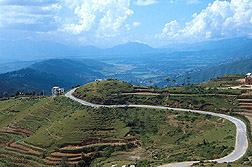This page has been archived and is being provided for reference purposes only. The page is no longer being updated, and therefore, links on the page may be invalid.
|
Read the magazine story to find out more. Related story: When new biocontrols are imported— |
Research Expedition Yields Potential New Control Agents for U.S. PestsBy Kathryn Barry StelljesApril 19, 2001 Giant reed, saltcedar, and pink hibiscus mealybug—invasive pests in the United States—may have new natural enemies, thanks to a foreign exploration trip to India and Nepal by Agricultural Research Service scientists and collaborators. Damage by more than 4,500 exotic or invasive species costs an estimated $130 billion each year in the United States. Giant reed (Arundo donax) and saltcedar (Tamarix sp.) have displaced native willow and cottonwood stands along waterways throughout the West. Pink hibiscus mealybug (Maconellicoccus hirsutus) was recently discovered in Southern California and has caused significant damage in the Caribbean basin. It attacks more than 200 plant varieties, including bean, citrus, cotton, corn, cucumber, grape, hibiscus, pumpkin, lettuce, peach and pear. All three pests are native to the Indian subcontinent. Scientists with ARS in Albany, Calif., and Montpellier, France, and a collaborator from the University of California in Berkeley spent three weeks in India and Nepal searching for insects and pathogens that might serve as biological control agents against the pests in the United States. The team collected 14 potential agents that were sent to the quarantine facility at the ARS European Biological Control Laboratory in Montpellier for further evaluation. They also set up collaborations with scientists in India and Nepal to continue research on these pests. An article describing their journey appears in the April issue of Agricultural Research, ARS' monthly magazine, and can also be found on the World Wide Web. ARS is the chief scientific research agency of the U.S. Department of Agriculture. Scientific contact: Raymond Carruthers, ARS Exotic and Invasive Weeds Research Unit, Albany, Calif., phone (510) 559-6127, fax (510) 559-6123, ric@pw.usda.gov. |

